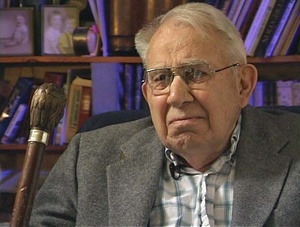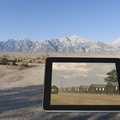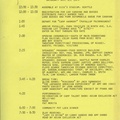Read Chapter 2 (4) >>
Visitor
One day, a messenger arrives at high school student Frank Yamasaki's barracks to tell him that he has a guest from outside. It seems that it wasn't raining in Puyallup that day.
I wondered who it might be, and when I went there, I found out it was a teacher from Queen Anne High School. I wasn't particularly close to the teacher, so I was a little surprised. We shook hands and started walking, but the teacher was very quiet. After a while, he asked me if there was anywhere we could sit and talk, so I led him to a special viewing area. When I got up there, I felt the atmosphere around me suddenly change. From there, I could see the whole camp like a perspective painting. Until then, I had never imagined there were so many rows of barracks. Everywhere else was flat.
… He told me about his experiences during World War I. He was of German descent, and his father had been put in an internment camp (in the US). He had had a similar experience. He said it was outrageous that something like this could happen. That was the first time I felt the gravity of the situation. Up until then, I had been a carefree teenager.
... I think that the teacher had been listening to me about the war and had been carrying the pain for a long time, so he felt that he had to tell me about it. It's a true story. It's horrible. I was still ignorant and didn't know anything about the Constitution, but when I met the teacher, a new page in my life began. I was able to see what was happening now from a completely different perspective. 2
Breed also visited Santa Anita on his way back from attending the American Library Association's conference, 3 in Milwaukee in June.
At exactly 1:30 p.m., Tetsu (Tetsuzo) and his sister Yaeko came into the visiting room with Louise, Margaret, and Fusa. Clara was first surprised to see that they were all suntanned. She was very happy to see them again, but there was also some awkwardness. It was not easy to make small talk across a large table. She had brought with her as many books and magazines as she could hold, as well as some candy. After being inspected by the guards, the items were given to the children.
Tetsu wanted to know how her trip to Milwaukee was. Fusa asked if things had changed in San Diego. … Clara also had a lot of questions to ask. Have you seen Jack Watanabe? How is Katherine doing? … “How are David and Elizabeth Kikuchi doing?” Just as Clara was about to ask that question, the guard said, “That’s enough. Visiting hours are over!” 4
After Breed returned to San Diego, he immediately received a letter from Louise dated July 15th.
I will never forget the day you came to visit me. When I saw your smiling face, my heart almost burst. I felt as if I would never see you again. I was glad to see that you were doing well.
Thank you so much for the delicious candy, soap, and the most interesting books. I have read Peggy in Washington and London and Peggy the Journalist. Emma Bagby's books are very interesting. 5
Rookie Reporter 6

(Photo: Densho, Densho ID: denshovh-wwalt-01-0005)
Just before the departure, without knowing where they were going or how long it would take to return, Walt Woodward, editor-in-chief of the Bainbridge Review, appointed Paul Otaki of Bainbridge High School as a reporter and instructed the novice reporter: "What did they do? How did the soldiers who accompanied them treat the Japanese? How were the elderly Issei? Did anyone get sick on the way? Write about 50 articles like these, and give them to a specific soldier when they arrive at their destination." Walt had asked the soldier to send it to the Review via Associated Press telegram.
The ferry left Bainbridge Island, gliding through the calm and beautiful Puget Sound on its way to Seattle, where the Japanese Americans boarded the train that was waiting for them. As the train set off, Paul was surprised to see several of his high school classmates running alongside the train, waving. They had made the effort to come all the way to Seattle to see them off. After that, they were rocked on the train with the blinds down for two days, then transferred to a bus, and arrived at Manzanar internment camp just after noon on April 1st. They were the first Japanese Americans from Bainbridge to be incarcerated at the camp. Here is Paul's impression at the time.
Our hearts sank more than ever. Even the soldiers who had brought us in couldn't believe what they were seeing. Some of the soldiers who were leaving us behind had tears in their eyes.
Paul's first article was inoffensive, with headlines such as "We all arrived in good health," "Everyone seemed to enjoy the trip, but I remember our friends on the island," and "On the train, we sang songs in groups, played cards, and talked with the soldiers in charge." However, decades later, Paul would record things he had not written at the time.
We were the first ones to be evicted, the guinea pigs. Many people on the island thought they would be here for a few weeks and then go home, but when they saw the barbed wire... Our first lunch was awful. Canned spinach... the same dark green as the army trucks... But what was even worse was that we got sick from this first meal. Many people had terrible diarrhea. Some even thought they had been poisoned. We found out later how this happened, because the kitchen staff were new and had not rinsed the first dishes thoroughly after washing them with a very strong detergent. At that time the toilets were not yet completed, and the toilets and washing areas were not usable... A long line of sick people waiting their turn formed. What a terrible first day.
Why do you think Walt chose Paul, a high school student, as a reporter? When Paul, who was gradually writing less and less, missed several deadlines and sent the Manzanar Free Press, the internment camp newspaper, instead of articles, the answer was in a letter Walt sent him.
Dear Lazy Person,
Hey, hey, the Manzanar Free Press was a great read...but where the hell is my Manzanar correspondent?
Seriously, hey tough guy, you'd be doing the Japanese people a huge disservice if you stopped sending all your gossip to the island. When this whole war mess is over and people want to come home again, the majority of the islanders will welcome you with open arms. But those who don't or don't understand won't be as welcoming and will actually cause problems.
But it would be a lot harder to stir up trouble if, week after week, you continued to give the impression in the Review that Japanese people had only been there a little while and still considered the island home. And it would be even harder if you could find and write about every little thing that Japanese people remember about the island. You know what I'm thinking?
So...enough with the lazy report. Let's put Otaki back on the front lines .
Notes:
1. During World War I, more than 4,000 German Americans were imprisoned in internment camps in the United States.
2. Frank Yamasaki, interview by Lori Hoshino and Stephen Fugita, August 18, 1997, Densho Visual History Collection, Densho.
3. The only time the internment of Japanese Americans was discussed at this ALCA conference was in a symposium organized by the Children's Library Division. Opinions were divided at this symposium, ranging from those who seriously questioned the national policy of internment to those who believed it was necessary for national security, and the ALCA was unable to issue an official statement. In his paper, Plummer Alston Jones Jr. wrote, "During World War II, the public library community was curiously silent about the internment of Japanese Americans." In many cases, it was individual librarians who delivered books to the camps, acting courageously and with personal responsibility.
Freeman, Robert S. & Hovde, David M.(Eds.), Libraries to the People: Histories of Outreach . Jefferson: McFarland & Co. Inc., 2003.
The conference also saw the award ceremony for the Caldecott Medal, which is given annually to the most outstanding picture book in the world, and in 1942 it was awarded to Robert McCloskey's "The Ducks Come True." Breed was on the selection committee that year, so it's nice to think that we are all connected to Breed through "The Ducks Come True."
4. "Dear Breed" (see above)
5. "Dear Breed" (see above)
6. Seigel, Shizue. In Good Conscience: Supporting Japanese Americans During the Internment. San Mateo: AACP, Inc., 2006.
7. Seigel, Shizue. In Good Conscience: Supporting Japanese Americans During the Internment. San Mateo: AACP, Inc., 2006.
"I was amazed at Walt and Mildred Woodward's insight.... As we were planning our eviction.... they were planning our way back home smoothly.... (After this) I began to think more seriously about reporting this news," Ohtaki said.
*Reprinted from the 134th issue (July 2013) of “Children and Books,” a quarterly magazine published by the Children’s Library Association.
© 2013 Yuri Brockett






